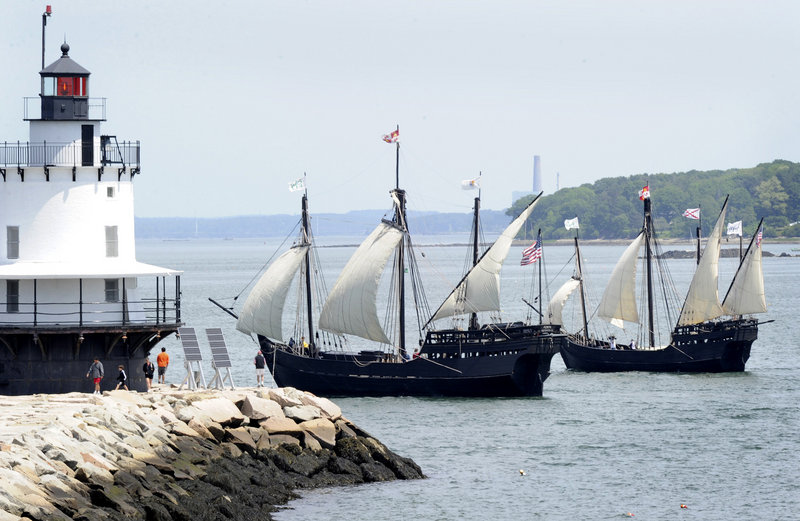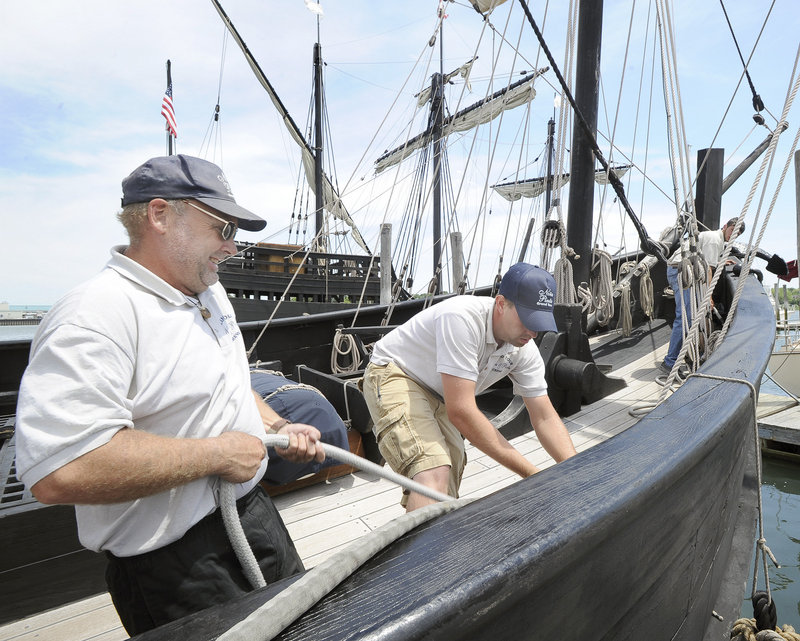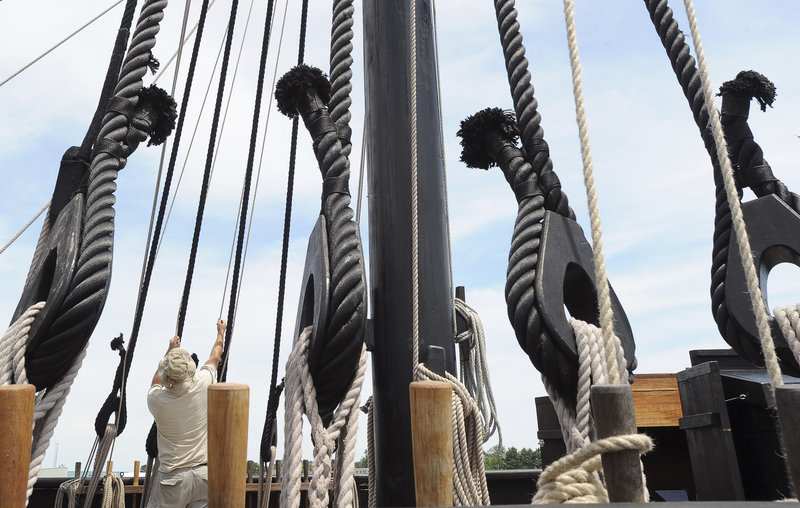“Haul away!” called Capt. Joe Hopkins, his blond ponytail blowing in the wind.
With a toss of the bowline, his crew brought the Pinta alongside the dock. The Nina wasn’t far behind, square sails furled, water lapping at its black hull.
The two replicas of Christopher Columbus’ 15th-century caravels pulled into port Wednesday afternoon at South Port Marine.
The vessels, which travel the Americas as floating museums, will spend the next five days in South Portland. Visitors can tour the ships between 9 a.m. and 6 p.m., starting today. Admission for adults costs $8. Information about tours is online at thenina.com.
The Columbus Foundation, based in the British Virgin Islands, launched the Nina in 1991 and the Pinta in 2005. The ships were built in the village of Valenca, Brazil, using 15th-century tools and techniques, after years of historical research.
The boats travel 11 months out of the year, stopping at ports to educate people about the history of the Portuguese caravels. They spend the 12th month in a shipyard for repairs and maintenance.
“Next stop is Bridgeport, Connecticut,” said Morgan Sanger, founder of the Columbus Foundation and captain of the Nina. The ships will spend the winter near Key West, Fla.
Sixty-five feet long and weighing 75 tons, the Nina is the most historically accurate copy ever built of the ship that brought Columbus to the New World in 1492. The Pinta, at 85 feet and 101 tons, is slightly bigger than the original.
Hopkins, who has sailed on the Pinta for four years, said the crew members on both ships are mainly students or retirees who are looking for adventure. “Some people fall in love with it,” he said.
“We have volunteers that join port to port,” said Sanger. “The hardest ones to find are cooks.
“We look for people who don’t get seasick, who are willing to live in close quarters with little privacy and do 16 hours on duty a day,” he said. “It’s not an easy life, but the travel is what they appreciate.”
Life aboard the rustic ships isn’t for everyone.
“Sometimes it doesn’t work out,” said Hopkins. “The shortest I’ve seen is about a week.”
Cole Lathrop joined the crew of the Nina two months ago. He was living in Stuart, Fla., when the ship arrived.
“They pulled into my home port,” said Lathrop. “I asked if they needed an extra deckhand. It’s been a blast.”
Lathrop doesn’t mind the trials of life at sea. “We’ve hit some rough weather, about 45 miles per hour winds over the port side recently, but that’s just playtime for me,” he said, grinning.
Though they can be sailed only by hand, the ships have engines and electronic navigation.
“For insurance and the Coast Guard, we have to have satellite, etc.,” said Sanger. “We couldn’t get away with rowing ships like they used to.
“We’ve been through the Panama Canal 10 times,” said Sanger. “Total, we’ve done 300,000 miles.” At about six miles an hour, that’s a lot of hours at sea.
“We had a great sail today,” said Vic Bickel, the first mate on the Nina. “Beautiful, actually. We came in under full sail on both ships, seeing five knots on the way in.”
“The tide was with us, and the wind as well,” said Hopkins. “Square-rigged boats were made to go downwind.”
Staff Writer Sophie Gould can be contacted at 791-6354 or at:
sgould@pressherald.com
Copy the Story Link
Send questions/comments to the editors.





Success. Please wait for the page to reload. If the page does not reload within 5 seconds, please refresh the page.
Enter your email and password to access comments.
Hi, to comment on stories you must . This profile is in addition to your subscription and website login.
Already have a commenting profile? .
Invalid username/password.
Please check your email to confirm and complete your registration.
Only subscribers are eligible to post comments. Please subscribe or login first for digital access. Here’s why.
Use the form below to reset your password. When you've submitted your account email, we will send an email with a reset code.